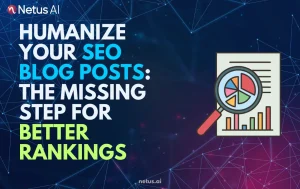
Why Google’s ‘Who, How, Why’ Framework Matters for EEAT | NetusAI
Why Google’s ‘Who, How, Why’ Framework Matters for EEAT AI can create articles in seconds. But here’s the truth: speed is not enough. Google wants
How to Check Plagiarism in Turkish: A Comprehensive Guide for Accurate Results

Content writer and editor for Netus.AI
How to Check Plagiarism in Turkish. The increasing popularity of digital publication has transformed the traditional landscape of content creation and distribution in multiple languages. This shift has made it easier for companies, institutions, and individuals to publish their work in various languages, including Turkish. In this context, it is imperative for content creators—be they students, writers, or bloggers—to ensure that their work is unique and free from plagiarism, as this is what readers expect regardless of the publication medium.
Given the prevalence of plagiarism in academic and online spheres, several tools have emerged to help detect and prevent it in different languages, including Turkish. These plagiarism checkers are crucial in maintaining the integrity and quality of content across digital platforms, as well as upholding professional ethics. With a significant percentage of academic theses in Turkey containing plagiarized material, it is crucial for content creators to utilize these tools to their advantage.
Plagiarism undermines the credibility of writers, as it prevents them from effectively conveying their thoughts to readers. It’s crucial for writers to check their work for plagiarism before publishing to maintain their reputation and integrity. In the academic context, plagiarism has significant consequences for students, institutions, and authors alike.
To mitigate the negative effects of plagiarism, writers must be diligent in ensuring the originality and authenticity of their work. By fostering creativity and adhering to ethical principles, writers can contribute positively to the academic, journalistic, and professional spheres.
To cater to the diverse needs of individuals and professionals worldwide, plagiarism checkers like Copyleaks offer support for over 100 languages, including popular ones such as English, Spanish, French, Hindi, Bengali, German, and Turkish. These tools can analyze texts written in Unicode languages, even those with complex Asian characters.
This extensive language coverage enables students and writers from various nations to ensure originality in their work. For instance, a person working with Turkish content can use the plagiarism checker to compare their document with other Turkish sources and receive a comprehensive plagiarism report.
Plagiarism checkers, like Turnitin and Scribbr operate by analyzing uploaded content and comparing it against a vast database of sources, including websites, articles, PDFs, and more. These checkers can process various file formats such as txt, doc, pdf, and others.
When an individual wants to check their work for originality, they upload the document to the plagiarism checker, which scans it for any similarity with existing content. These detectors evaluate the text for duplicate phrases or sentences and highlight any potentially plagiarized material. They can also provide a similarity report with a percentage that represents the amount of content that may be plagiarized.
To avoid plagiarism, writers and students should properly cite the original sources they use. If quoting another author’s work, ensure accurate quotation marks are placed around the text and the correct citation is given. By employing the use of plagiarism checkers and adhering to proper citation practices, individuals can ensure that their work remains original and free from plagiarism risks.
In order to maintain academic integrity and create high-quality works, it is crucial for students, researchers, and writers to steer clear of plagiarism. Here are some effective strategies for ensuring originality in your writing:
Remember, the key is to remain transparent, informed, and resourceful when composing your work, and to always give credit when credit is due.
Utilizing a grammar checker is crucial for writers to ensure originality in their work. These checkers provide a free report identifying plagiarized sections, allowing for necessary modifications. A premium report and monthly subscription option may also be available for more comprehensive writing analysis. This can include a downloadable word document with track changes functionality. The recurring fee structure and prices per document vary, with refunds depending on the checker’s validity and reliability.
There are several free tools available for detecting plagiarism in Turkish texts. Some popular options include the Copyleaks plagiarism detector and the Scribbr plagiarism checker. These tools can effectively analyze Turkish content and detect similarities with other existing content.
Yes, many plagiarism detection tools have the ability to check plagiarism in Turkish PDF documents. They can analyze the text within the document and compare it against their database to detect any similarities or duplicated content.
To use online plagiarism checkers for Turkish content, simply upload or paste the text into the tool. The checker then processes and analyzes the text, comparing it to its database of existing content. It highlights any similarities or duplicated sections and provides a comprehensive report on the plagiarism percentage.
Some plagiarism detection services, like Turnitin, are designed to cater to the needs of Turkish academic writing. These services often include support for Turkish language content and other features specific to Turkish academic writing standards.
The Scribbr plagiarism checker is known to be one of the most accurate plagiarism checkers on the market. Though it supports the Turkish language, the actual accuracy may vary depending on the specific content being analyzed. In general, Scribbr’s checker is capable of detecting exact word matches as well as synonym swapping.
Yes, the Turnitin plagiarism service is effective for checking documents written in Turkish. Its comprehensive database of web and publication content aids in identifying any similarities or duplicated sections in the Turkish text. This makes it a suitable option for analyzing and detecting plagiarism in Turkish documents.

Why Google’s ‘Who, How, Why’ Framework Matters for EEAT AI can create articles in seconds. But here’s the truth: speed is not enough. Google wants

SEO Writer’s Guide to Google’s Helpful Content Update Keeping up with Google’s algorithm changes can feel like a relentless game of whack-a-mole. Just when you

Can AI Content Be Safe for SEO in 2025? Let’s start with the question of keeping every content strategist, SEO pro and blogger awake at

Humanize Your SEO Blog Posts: The Missing Step for Better Rankings You’ve done everything by the book. Your keyword research is impeccable. Your meta descriptions

How to Pass AI Detection Tests as an SEO Writer Let’s paint a familiar picture. You’ve just finished a blog post. The headline is sharp,

Why Your AI SEO Blog Isn’t Ranking (And How to Fix It) You embraced AI for your blog. The promise was intoxicating: high-quality content, published
@ 2024 Netus AI.